(Plus some ’70s too.) Because it’s Thanksgiving, get it?
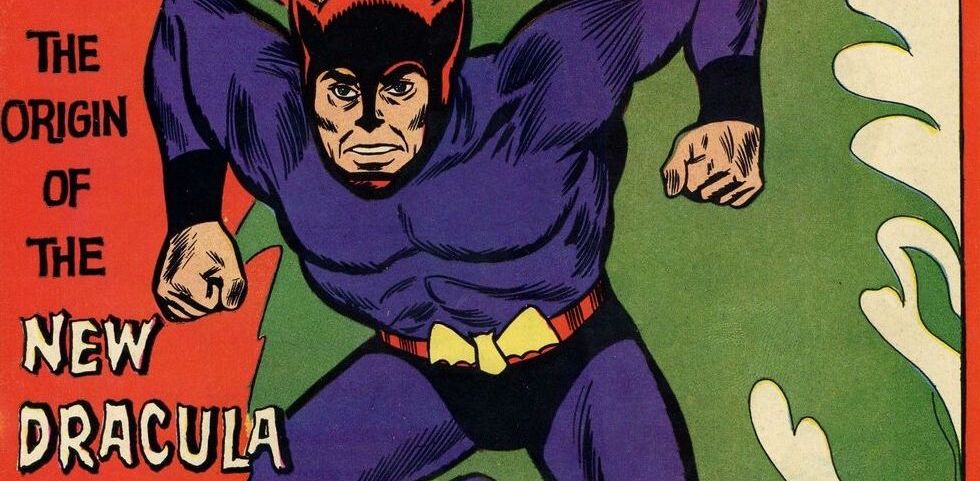
—
UPDATED 11/25/21: Happy Thanksgiving! This column by Paul Kupperberg first ran in 2020 — perfect time to re-present it! Enjoy the parade, the football, the turkey, the pumpkin pie and the nap! — Dan
—
By PAUL KUPPERBERG
Here, to ponder between plays of the Thanksgiving football games or the Purina commercials during the America Kennel Club finals, are my very favorite 1960s comic book turkeys.* But, be warned: I come to praise these comic book turkeys, not carve them up, no matter what the season.
I’ve made no secret here of my love for cheesy comic books and the 1960s offered me a lot to love. But not all cheesy comics are created equally cheesy. Some are cheese from concept to published book; others become cheese despite the best intentions and hard work of their creators. Most of the time, you can tell the difference. Others, it’s a fine line between Velveeta and a good brie.
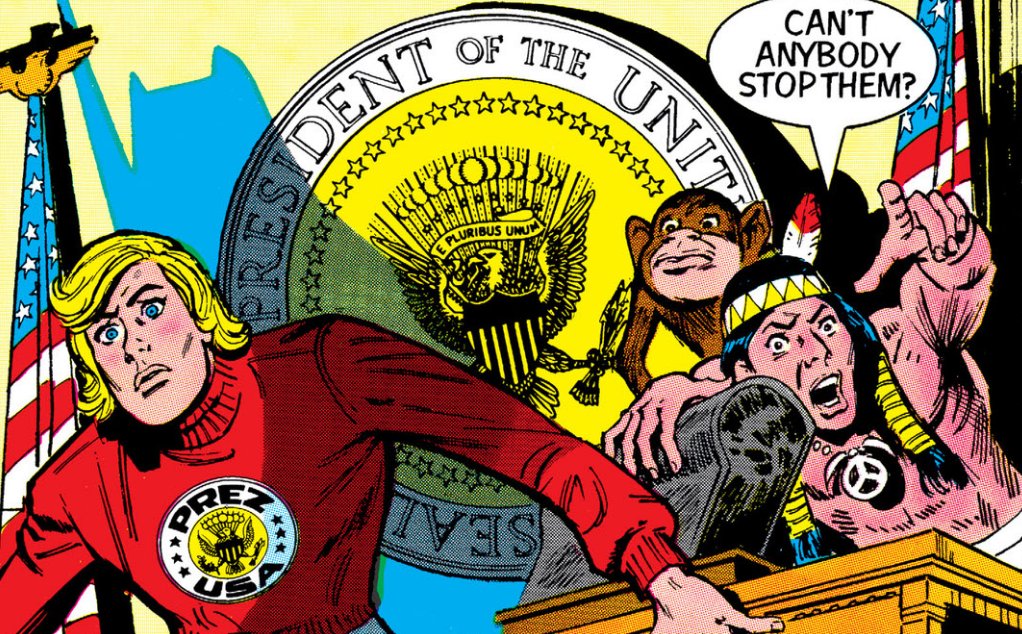
But enough with the food metaphors! In alphabetical order, let’s get on to the main course!
(Sorry.)
* Yeah, so I’m cheating: A few of these are from the 1970s, but they still have that bad ’60s vibe to them. Who’s it going to hurt?
—
1. Brother Power, the Geek #1-2 (DC, Sept./Oct. – Nov./Dec. 1968). The 50-plus-year-old men who ran DC Comics in the 1960s knew there was a “youth market” out there, but they had no idea how to tap into it. Not that they let that stop them from trying. Brother Power was one of the lamest but most delicious attempts of the decade.
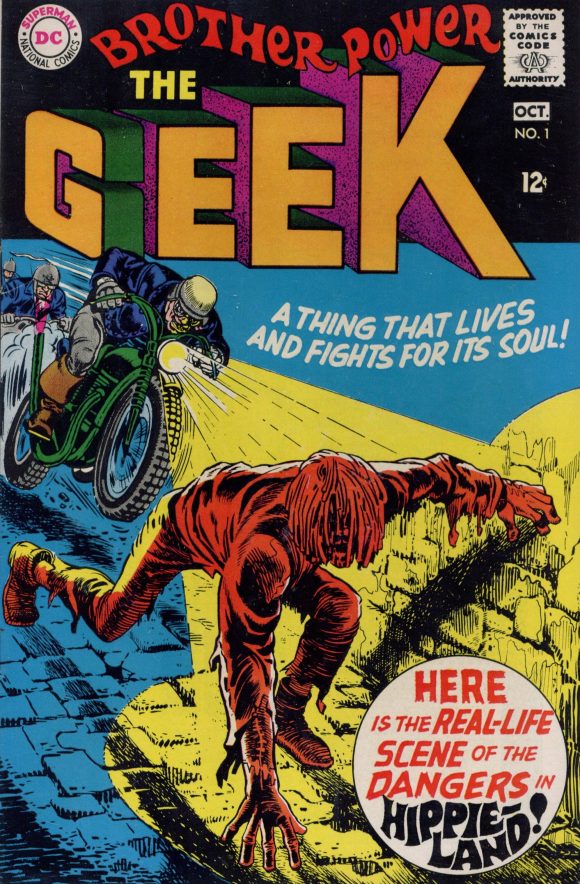
Created, written, and drawn (with an assist from penciller Al Bare) by 57-year-old Joe Simon (co-creator of Captain America with Jack Kirby), Brother Power was a discarded clothing dummy that’s brought to life by a bolt of lightning and tries to find a place for himself in the hippie culture of the 1960s. There was a message in there, somewhere, about acceptance and love, but it was tough seeing past the concept to find it.
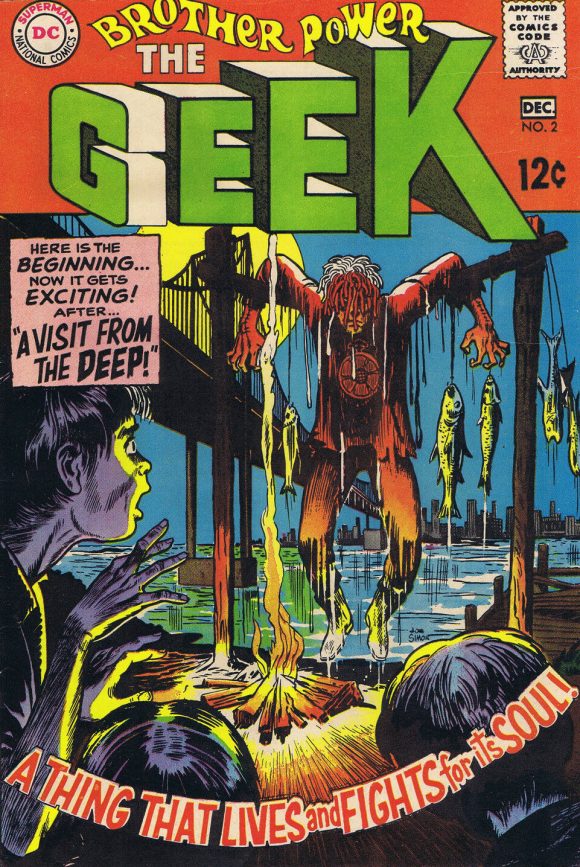
I don’t know Simon’s politics (my sense is he leaned left, but I could be wrong), and while Brother Power was far out, groovy, and well-intended, it missed the mark by a wide enough margin that it tumbled over the edge into parody.
—
2. B’wana Beast (DC, Showcase #66-67, Jan./Feb. – March/April 1967). Yes, I know I wrote about B’wana Beast just last week in my 13 FAVORITE MIKE SEKOWSKY COMICS in honor of the artist’s birthday, but I can’t let bad timing be the cause of omitting this jungle travesty from any list of 1960s turkeys.
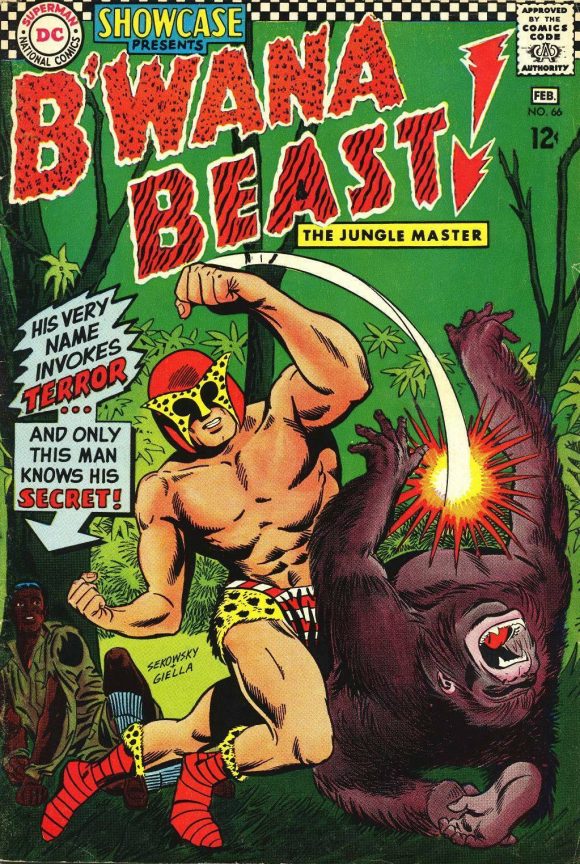
Joe Giella inks
I guess on the face of it, in light of what was going on in comics at the time, the idea of a guy who could control and merge animals wasn’t the worst one in the world (see entry #7, Fruitman). Like any concept, it’s all in the execution (except for maybe Fruitman). This one was executed as the Great White Hunter in Africa gaining the power over the local fauna to help out the overwhelmed natives. Ouch.
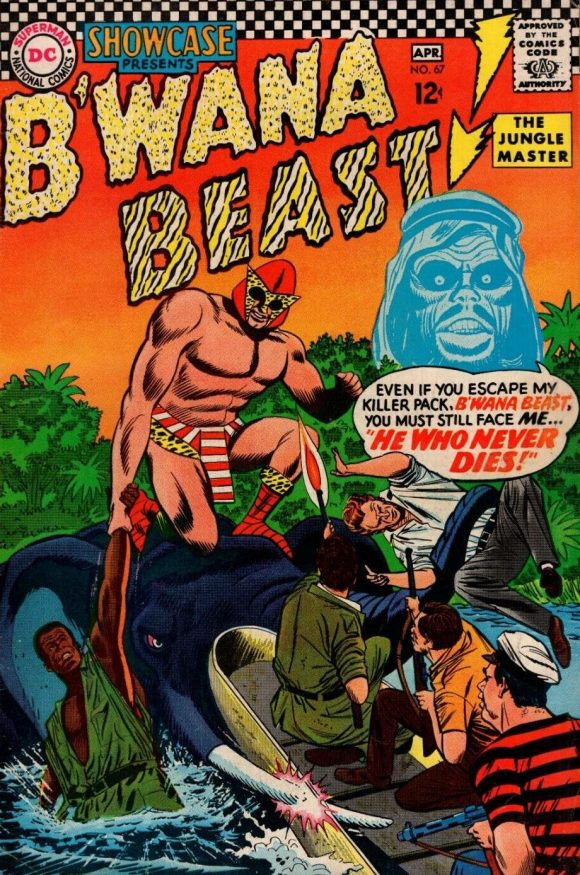
Jack Abel inks
B’wana Beast began as an object of derision for its just plain badness, then was rediscovered by a later generation of fans in Animal Man in the 1990s, before taking on an almost ironic, nostalgia status. But, honestly, there was a reason this turkey lasted only two tryout issues in Showcase and no one’s ever bothered to take credit for writing the original stories (best bets are either Sekowsky himself or Bob Haney).
—
3. Dingbats of Danger Street (DC, First issue Special #6, Sept. 1975). The beautiful thing about Jack Kirby was that he was never afraid to take a swing at an idea, no matter how, er… challenging it might have been. A boy and his dinosaur? Why not! A guy wrapped in aluminum foil who travels the universe on a surfboard? Sure! (Who else thinks 1966’s Silver Surfer was inspired by Beach Blanket Bingo and the rest of the 1960s Frankie and Annette surfer movies?)
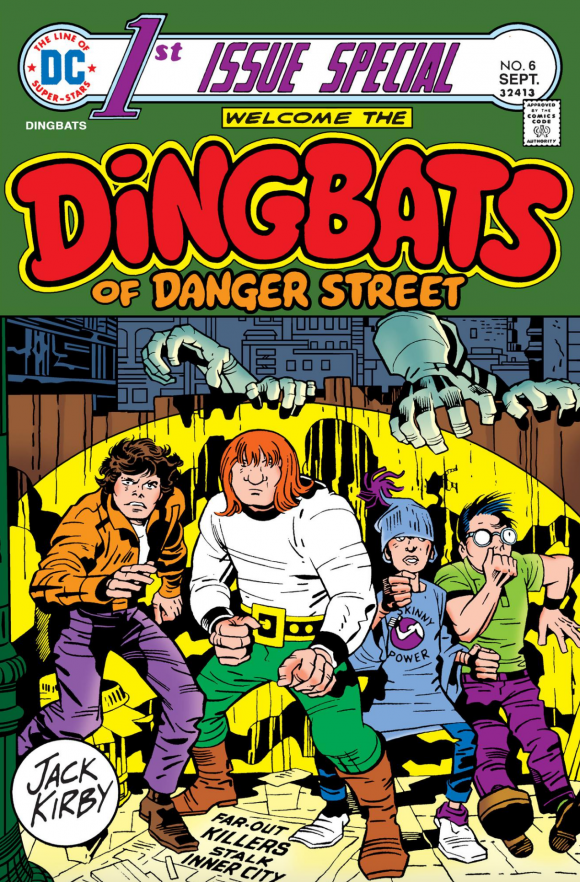
The Dingbats was a kid gang, à la the Young Allies, à la the Newsboy Legion, à la the Boy Commandos, à la Boys Ranch, (à la Challengers of the Unknown…?), à la “King.” Kirby built a “one from column A, one from column B” quartet of kids who depended on one another for their survival in the dangerous world of their rundown urban neighborhood. Like all Kirby kid gangs, they’re on their own except for the titular oversight of an adult authority figure, in this case, a gruff police lieutenant.
By the time Dingbats was published, Kirby was already back at Marvel Comics, but chances are DC would have followed through anyway with the two additional issues Jack had completed if not for the disastrous events of the devastating “DC Implosion.” Or, maybe it was a little bit of that dark cloud’s silver lining. (For more on the Dingbats, click here.)
—
4. Dracula #1–3 (Dell Comics, Oct./Dec. 1962–Feb. 1967). 1962’s Dracula #1: a fairly standard licensed adaptation of the 1931 Universal Studios horror movie. Four years later, Dracula #2: What the hell? Dracula’s descendant, a doctor living in the old family castle in Transylvania, is conducting experiments with bat blood to cure brain damage.
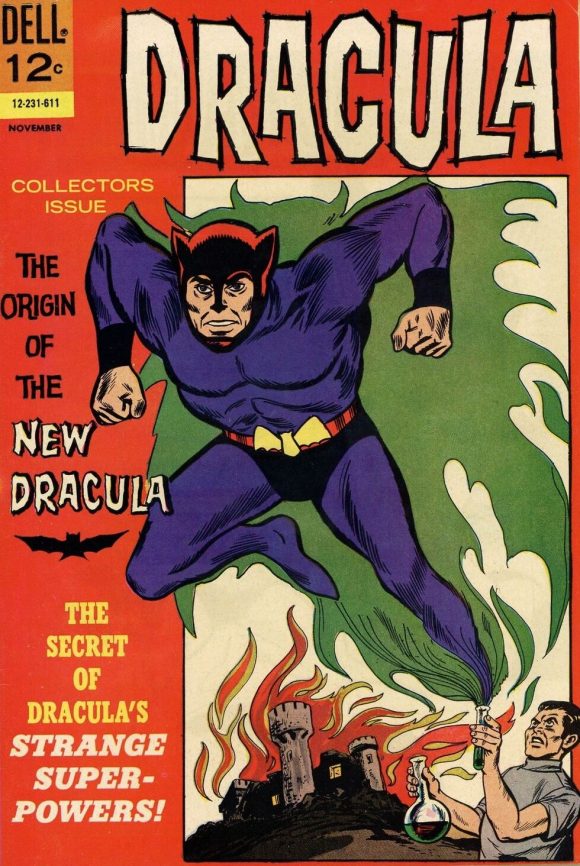
But you know what happens when you fool around with bat-brain serum! Accidental exposure, bat-like powers (none including blood sucking), and a pledge to use his newfound powers (after developing his body to the peak of physical perfection, of course) as a costumed superhero to redeem the family name.
This brain (damaged) child of writer D.J. Arneson and artists Bill Fraccio and Tony Tallarico (King of 1960s Cheesy Comics) could have used a good dose of bat-blood serum itself, but Dracula’s girlfriend took the hit instead to become his sidekick, the costumed Fleeta (from fledermaus, das German for bat, ja?). Mercifully, this bloodless concept was done with after two brief but memorably bad outings.
—
5. Fatman the Human Flying Saucer #1–3 (Lightning Comics, April 1967–August/September 1967). Here’s another one of those high concepts that sounded better in theory than they were in execution: reunite the Captain Marvel creative team of writer Otto Binder and artist C.C. Beck on a new superhero for the 1960s! What could go wrong?
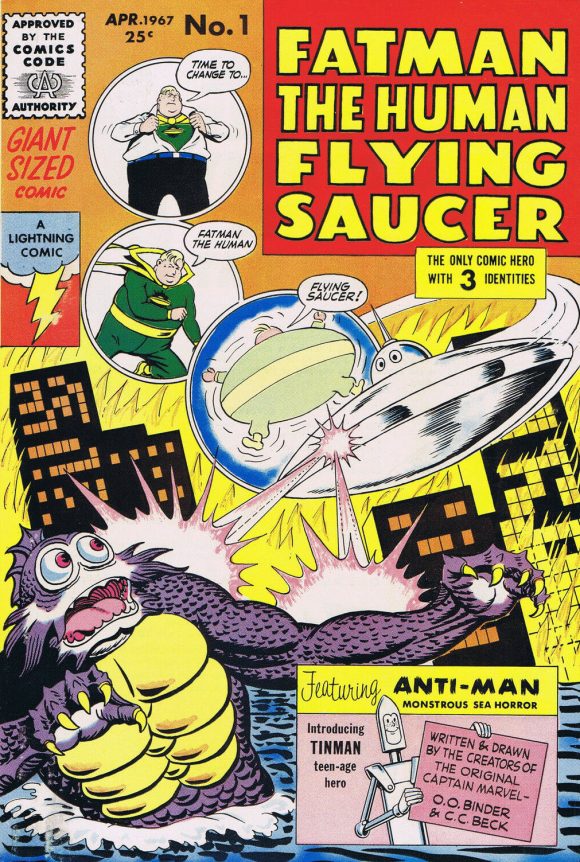
Well, first and foremost, Fatman, aka Van Crawford, overweight multi-millionaire, was no Captain Marvel. Not by a longshot. A fat dude who’d been given the power to shape-shift into a “human flying saucer” by a grateful alien somehow lacked the charm of Billy Batson and the Big Red Cheese. Also, it was the 1960s, Jake; their 1940s Captain Marvel sensibility was just out of step with the times.
Short-lived publisher Lightning Comics proved tone deaf to the market with a second title, the jingoistic Tod Holton Super Green Beret, also by Binder and artist Carl Pfeufer, which transferred the Billy Batson/Captain Marvel dynamic to a boy and his Viet Cong crushing alter ego. That lasted a mere two issues.
—
6. Frankenstein #1–4 (Dell Comics, March/May 1963-March 1967). Dell Comics’ Dracula title was part of a licensed package deal with Universal for their iconic movie monsters. Next out of the gate was Frankenstein; it too featured an adaptation of the 1930s Universal movie in its first issue but returned for a second issue two years later as… something else.
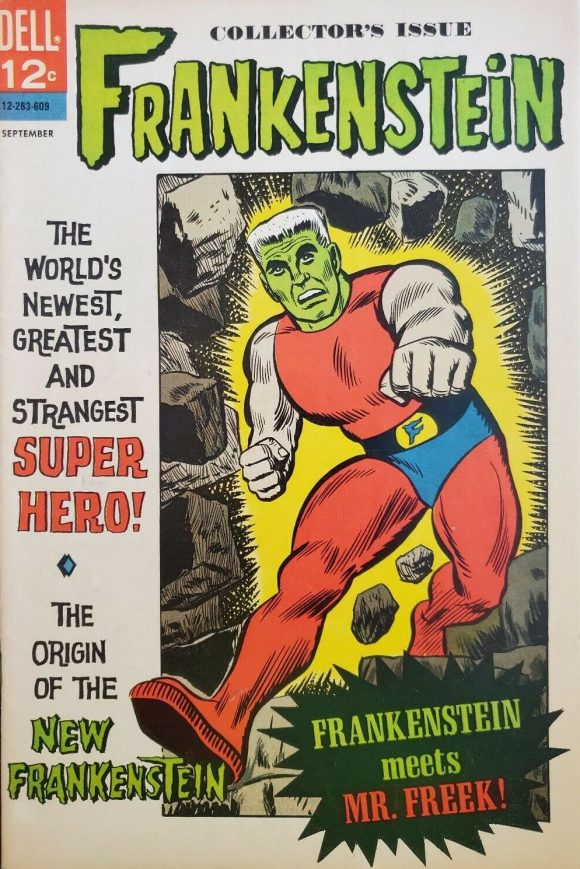
Another Arneson/Tallarico production, this iteration of the Frankenstein story saw the monster revived after a century and taking on a life-like rubber mask (to hide his green skin) and a secret identity (Frank Stone). A happy coincidence sees Frank do a good deed for which he’s rewarded by inheriting a fortune, which, of course, frees him up to put on red and blue tights and fight evil with the help of a miniature mad scientist, Mr. Freek, a pet gorilla named Bruto, and a faithful butler who’s the only one to know his secret identity. There’s also a nosy lady journalist who’s always trying to prove Frank Stone is really Frankenstein.
So. Yeah.
—
7. Fruitman Special #1 (Harvey Comics, Dec. 1969). His secret identity is Percival Pineapple. He can change himself from short, pudgy bespectacled Percy into any fruit of his choosing. He slips up criminals with his banana peel. He blinds them with a squirt of lemon juice to the eyes. He hides in a fruit bowl as a pineapple to eavesdrop on dastardly plots. He’s a greengrocer and a nice guy, for to be a true hero, one must be purée at heart.
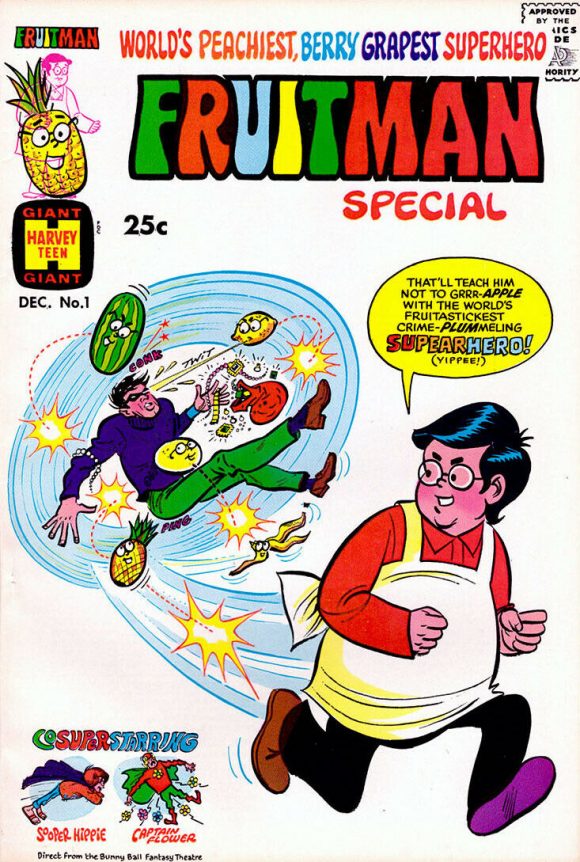
Did I mention there were also a lot of fruit puns? I think that may have even been the raisin d’etre for the existence of this one-off giant-size special starring a character created by Hy Eisman. It certainly wasn’t for the superheroics, although Fruitman got himself into a fair share of jams. (I’ll stop now.)
Alas, aside from its kitsch value, Fruitman is one of those comics whose existence you’d want to hide from anyone you were trying to convince of the value of the comic book art form. It’s the punchline to the idea that you could take any word, stick “man” or “Kid” or “girl” after it and it becomes a superhero name. This is the one that proves that whole idea is just bananas. (I lied.)
—
8. Green Team (DC, First Issue Special #2, May 1975). Joe Simon never took his eye off the youth market and, surprisingly, he seemed to make a small inroad with Green Team, yet another kid gang (he co-created a few of the earlier mentioned ones with Jack Kirby). Only this time, the kids were loaded!
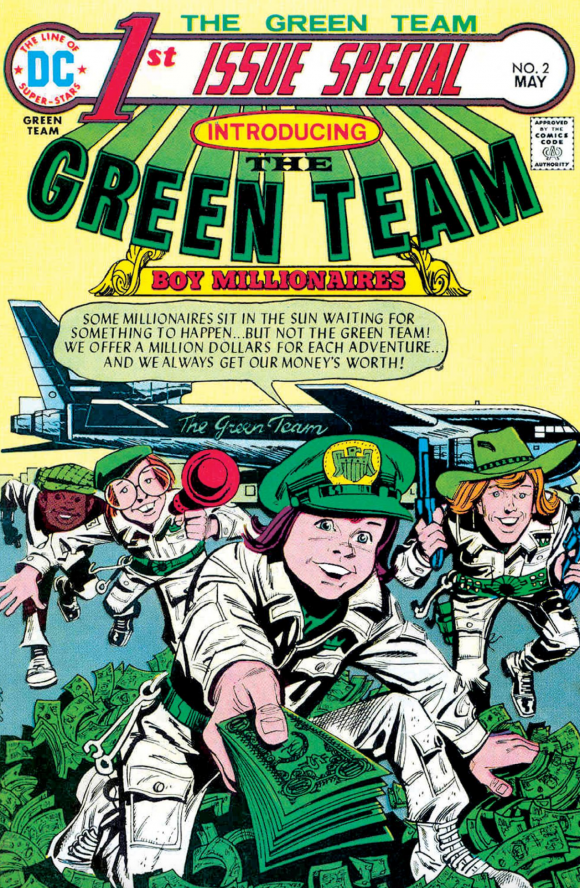
The “green” in the name wasn’t for the environment; it was for greenbacks. Bucks. Shekels. Moolah. Cash. They were four preteen millionaires — Commodore Murphy, J.P. Huston, Cecil Sunbeam, and Abdul Smith (the only African American member of the team, he’s also the only one of the millionaires who used bank fraud to earn his fortune from his shoeshine boy roots — who used their wealth to seek out action and adventure.
After their tryout in First Issue Special, Green Team proved successful enough to be picked up for an ongoing series, and the first two issues were completed (the art on all was by the talented Jerry Grandenetti). But as fate would have it (>choke! gasp!<), any further adventures of the boy capitalists were cut short by the previously mentioned “DC Implosion,” which led to the title being cancelled before the first issue was published.
—
9. Night Nurse #1–4 (Marvel Comics, Nov. 1972–May 1973). Comics were in a transformational period in the early 1970s, going from publishers of general subjects (superheroes, Western, romance, science fiction, etc.) to focusing almost exclusively on superheroes.
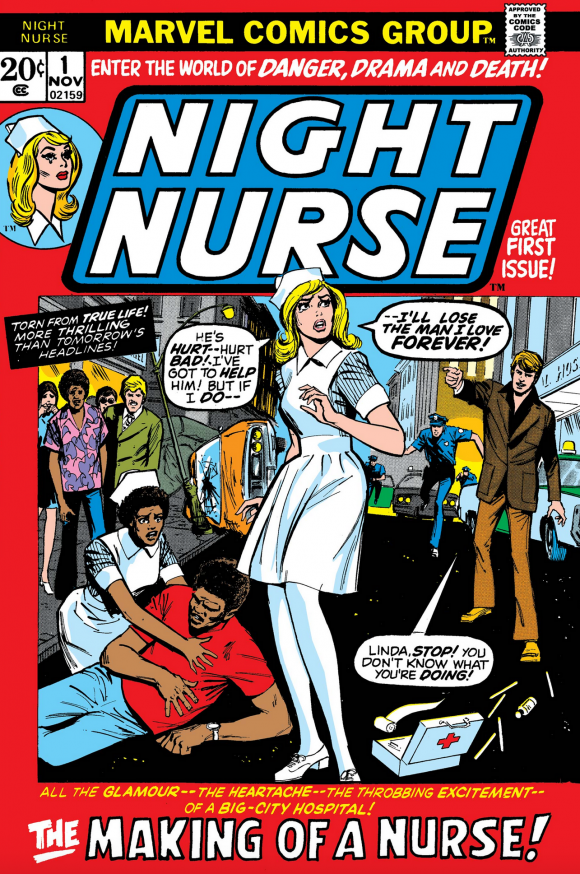
If memory serves me (and there’s no reason to believe it does), Marvel was pretty much out of the romance/“girly” comics business by 1972, with Millie the Model, now less a romance title than a clone of Archie Comics, limping toward cancellation at the end of 1973. Into that came Jean Thomas’ Night Nurse, starring Linda Carter, a young woman torn between love and duty, a soap opera in scrubs. There was romance, medical drama, blackmail, and intrigue. In the last issue there was even a touch of Gothic horror in “The Secret of Sea-Cliff Manor!”
I know I wasn’t the audience for Night Nurse, but it was a Marvel Comic, and it did have cool covers by John Romita, so a few issues may have slipped into my reading pile. And the art was by Win Mortimer who, while more famous these days as the artist on Spidey Super Stories, was a favorite of mine from his DC work in the 1960s (and with whom I’d get to work on the Supergirl strip in Superman Family in later years).
—
10. Prez #1–4 (DC Comics, Aug./Sept. 1973–February/March 1974). Joe Simon played “what if?” with the 26th Amendment (lowering the voting age to 18) by also lowering the age to run for elected office to 18 years old. Which opened the door for a story about a corrupt political boss who tries to run young Prez Rickard for office only to discover their high school-age candidate has a mind of his own, man!
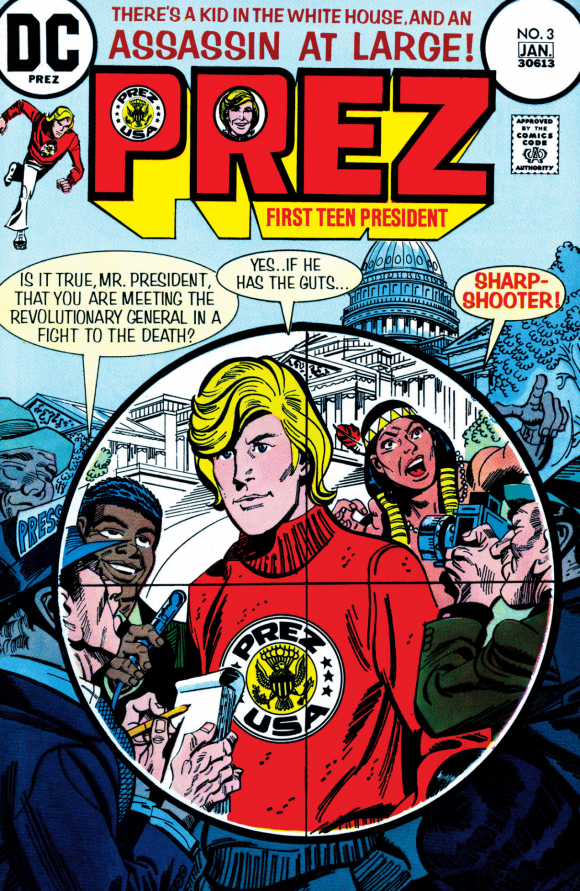
Prez is politics as action/adventure sport, likely inspired by the 1968 political thriller Wild in the Streets. The bad guys are Russian chess champions, right-wing fanatics who try to take over the country when Prez outlaws guns, and Dracula and an invasion by Transylvania. Prez’s best friend is Eagle Free, a Native American youth who wears goes around bare chested, wearing moccasins and a feathered headdress, and whose main job seemed to be pointing off-panel and warning Prez of incoming danger.
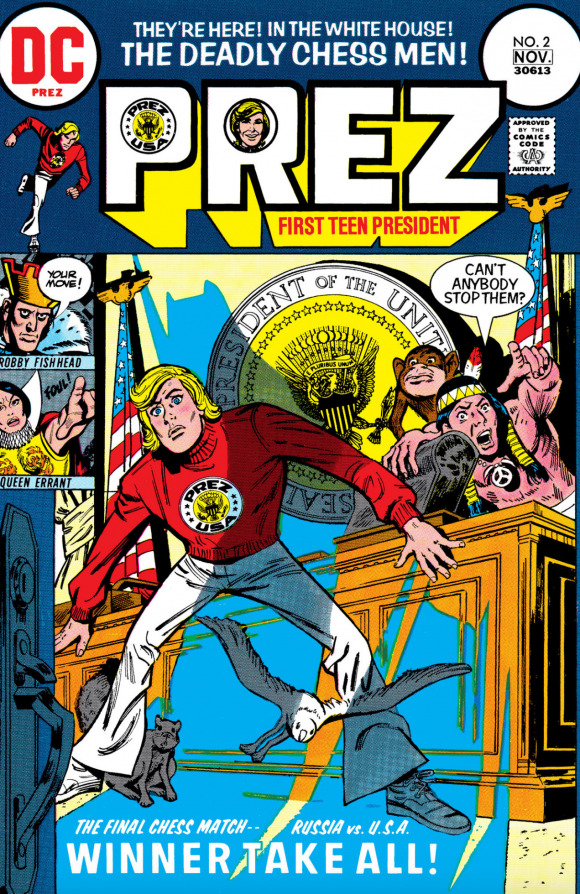
Once again, a tip of the hat to the art of the talented Jerry Grandenetti, but otherwise, like his earlier Brother Power, the Geek, Simon’s comics for the youth market missed the mark. Created during the turmoil of Watergate, Simon no doubt thought he could connect with readers who were protesting Nixon’s corruption by making a fictional president who was one of them, but Prez’s term in office was even shorter than Tricky Dick’s.
—
11. The Shadow #1-8 (Archie Comics, Aug. 1964-Sept. 1965). There was so much wrong with this Archie Comics adaptation of the venerable radio and pulp character, the Shadow, it’s hard to know where to start. The Paul Reinman cover of the first issue featured the familiar slouch hat wearing, hawk-nosed caped character hiding in the shadows, but the Paul Reinman art on the inside starred a blond-haired Shadow in a blue and green skintight costume and cape.
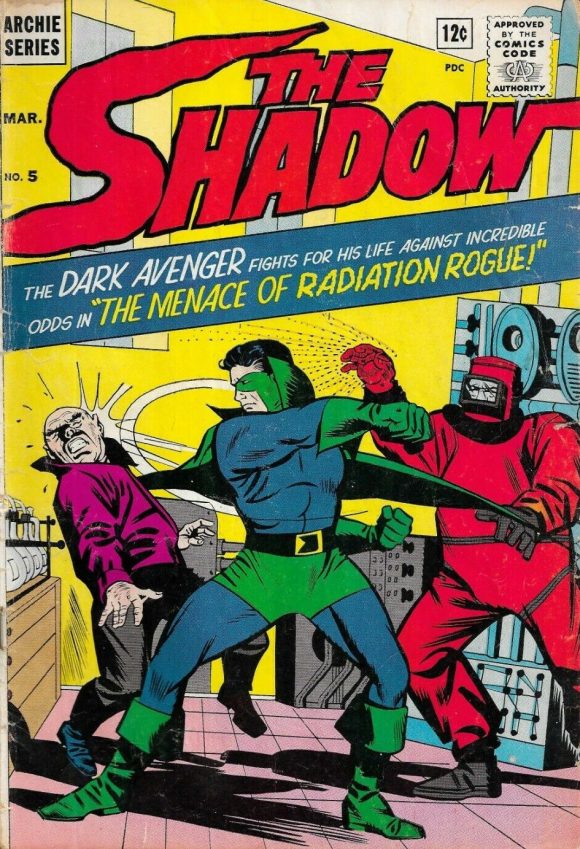
The primary villain in this short, ill-conceived series was Shiwan Khan, descendant of Genghis Khan, and a character (at least in name) out of the pulps. But Super-Shadow also battled “the invulnerable Brute,” “the insidious Elasto,” and “the menace of the Radioactive Rogue,” more superhero than international man of mystery.
Of course, considering the stories were written by two veteran superhero writers, indeed veteran writers of the superhero, Superman, Robert Bernstein (#1-#3) and Man of Steel co-creator Jerry Siegel on the rest, it’s a wonder this series didn’t revamp Lamont Cranston’s origin to have him rocketed to Earth from some distant planet.
—
12. Super Heroes #1-4 (Dell Comics, Jan.–June 1967). Here’s another returnee from a previous column, my 13 FAVORITE SHORT-LIVED SERIES OF THE 1960s. As much as I loved this series about four kids who gain the ability to transfer their minds into a quartet of superpowered androids, I think I knew even at the time that it wasn’t very good. At all. No writer has ever stepped up to claim credit for creating or writing it, and the art by Sal Trapani was, you know, art by Sal Trapani.
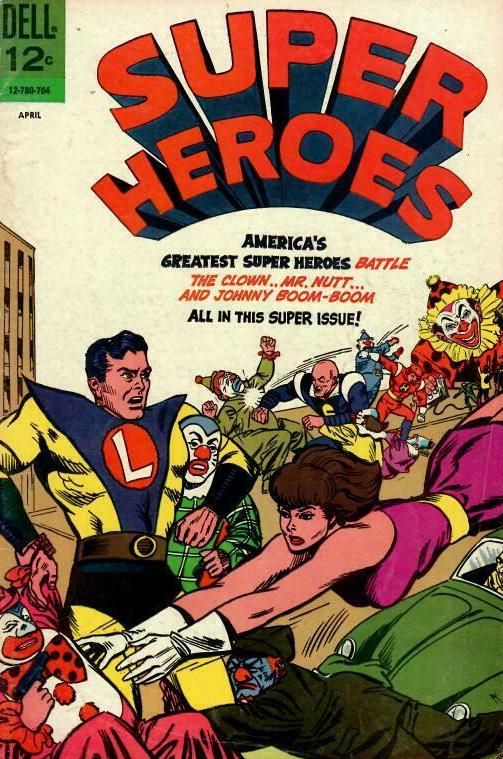
In retrospect, I think the simplicity of the “Fab Four” stars of Super Heroes was what attracted 11-year-old me to the comic; as I say, “the golden age of comics is whatever you were reading when you were 11 years old.” And, at the time, they didn’t seem all that much better than something I might be able to produce in the not-too-distant future, just a few steps ahead of the comics drawn on lined notebook paper that I’d been making since I was 7. Maybe that was the appeal of all the cheesy comics of the era that I loved. A kid, even one with talent (and my drawing skills peaked at the level of a slightly above-average 12-year-old) couldn’t say the same thing about the art of Carmine Infantino or Jack Kirby.
—
13. Werewolf #1-3 (Dell Comics, Dec. 1966-April 1967). And then came the third of Dell’s monster titles, Werewolf. This one, though, never came within a thousand miles of the Universal Wolfman movies. In this incarnation, USAF pilot Maj. Wiley Wolf (get it?) crashes his experimental aircraft in the Arctic and has amnesia for six months, during which he runs with a pack of wild Canadian wolves, one of whom, Thor, becomes his BFF.
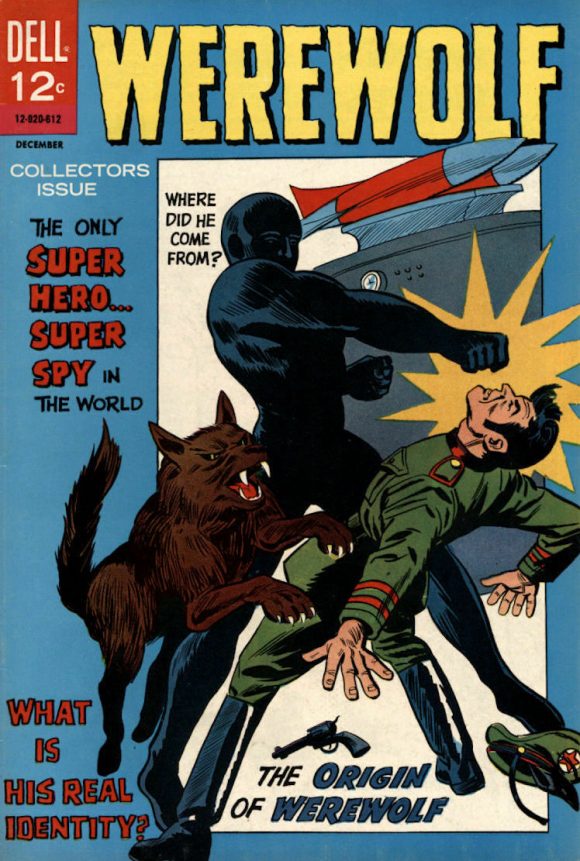
When he finally remembers who he is and returns to civilization with Thor (don’t judge them!), he finds that everyone believes he’s been dead all this time. Wiley is recruited by the CIA, trained out the wazoo, given a cool black suit full of spy gadgets and is unleashed as codename “Werewolf” to fight for truth, justice, and the American way.
Created and written by either D.J. Arneson or Don Segall and drawn by the ever reliable but seldom exciting Bill Fraccio and Tony Tallarico, Werewolf fought some commies and reds and then slunk off under the front porch to die.
—
Paul Kupperberg has been writing comic books from Archie to Zatanna for 45 years at DC, Archie, Charlton, Marvel, Bongo and others. He is also the author of Paul Kupperberg’s Illustrated Guide to Writing Comics (Charlton Neo Press); I Never Write for the Money… But I Always Turn in the Manuscript for a Check (Comics Career); the comic book industry-based murder mystery The Same Old Story, the short-story collection In My Shorts: Hitler’s Bellhop and Other Stories, and JSA: Ragnarok (all from Crazy 8 Press), all of which are currently — or shortly will be — available at Amazon.
—
MORE
— PAUL KUPPERBERG: My 13 Favorite Short-Lived Series of the 1960s. Click here.
— PAUL KUPPERBERG: My 13 Favorite 1960s Comic Book Books. Click here.

November 25, 2020
The cover of Geek #2 reminds me of the premiere of “Smallville”. Still digesting the rest…LOL
November 25, 2020
What? No Captain (split) Marvel?
November 25, 2020
So many bad comics, so few slots!
November 25, 2020
I agree with your assessments of Dingbats of Danger Street & The Green Team. I knew they were loser propositions even as I read them when they came out. But I bought every issue of 1st Issue Special, no matter how bad they were. However, I think you might be mistaken about the reasons for why they didn’t go to series. It’s possible that Jack Kirby’s return to Marvel was the factor in cancelling Dingbats. The timing was sort of close. However, I suspect that Infantino just pulled the plug based on what he saw coming in. After all, by that point Kirby was doing Kamandi & Our Fighting Forces, which were solid sellers. Dingbats looked like a half-baked throwback to another time. I’m sure Mark Evanier would be the authority on that.
The Green Team was published in 1975, and the DC Implosion occurred in 1978. It’s hard to see any correlation between the two. More likely, The Green Team was aborted as DC and Joe Simon cut ties. My assumption is because all of Simon’s projects for DC failed to yield much if any success. I certainly found them all weird when I was a kid back then.
November 25, 2020
I myself read the Dingbats issue when it came out on the newsstand (yes, I’m that old), At the time, I wasn’t as Kirby savvy as I have become, and read very few Marvels up until then (I was and still am a diehard DC guy), but reading Paul’s description above, and the Kirby Kontext mentioned, made me think if Dingbats wasn’t an alternate version of Kirby working a concept of a Marvel Yancy St, Gang idea he may have had percolating in his brain for some time. Any thoughts?
November 25, 2020
Another article well done right here. 🙂
November 28, 2020
I remember buying the first issue of Archie’s Shadow series which I recall having art by John Rosenberger with no super hero ties at all. I know in the later issues he was more of a super hero but not in the first issue.
November 29, 2020
Honorable Mention prize to Harvey Comics “Jigsaw”, an astronaut who escaped near death by being reconstructed by aliens, into a stretchy puzzle-man. Pure awfulness.
November 25, 2021
Forget Fatman, I want to know more about the teenaged Tinman, who appears at first glance to be the inspiration for Windows 95’s “Clippy.” Happy Thanksgiving to all, and a special thanks to all the contributors at 13th Dimension for all the joy, fun and nostalgia you provide all year long!
November 25, 2021
Thank you, Greg — and all our loyal readers! It really means a lot! — Dan
November 25, 2021
Prez may have been targeted to Watergate-aware youth, but its plot was definitely Mr. Smith Goes to Washington meets Wild in the Streets.
November 29, 2021
You nailed 14 of my worst comics ever. I’d add ME’s Captain Marvel issues; Son of Vulcan, ultra tje Multi-Alien in MIS, The Green Glob in Unexpected, Manny Stallman’s Raven, Todd Holton Super Green Betet.
April 22, 2022
I remember Prez and also that ridiculous Green Team… I bought all the Prez issues, although I thought the concept itself was stupid. But something pulled at me… Grandenetti’s art, I guess—it’s vivid and memorable, and even at 13 I bought for the art in a title. The stories in the book certainly confused me… seemed chaotic, even random. Like the times themselves…